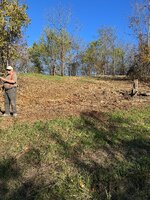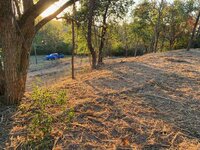GF bought 10 acres on a ridge top to build a house. Typical land lay, flat, hill, flat on the build site. Power lines run on the bought of the property and its flat. From what I understand from the AEP site and what little research I've done, you can build a driveway along a power line right of way as long as you are far enough from the poles and don't change the elevation, as in do add or remove dirt. She does not want to use this route, plus it woukd need approval from AEP I figure.
GF and her dad have chose a route that requires, what I call significant earth moving. Basically cut through a hillside by the county road and come in that way. Mutual friend of ours does driveway work and bid the project. Big stone base and working smaller to the top and placing some sort of mat in between the stone to "lock" it all in. A drain ditch on each side and culverts I think every 100 to 200 feet. The driveway is around 600 feet long.
His price is $44,000.00
He owns 2 small dump trucks a bob cat with attachments and a small john deer tractor with bucket and backhoe. He says he will sub with a friend that has a dozer and an actual excavator. And have the stone brought in by tandem axle dumps as they can haul more and make less trips.
I paid an actual small excavating company to come an mulch a couple acres and he said you dont need to use matting or culverts, just crown and ditches in build of the driveway. He said he would use just two different size stone. He has all the equipment and bigger dumps to haul stone.
His price is around $25,000.00
I don't anything about driveways or home building. These prices sound right? This is south east Ohio, so the land is foothills of the Appalachian mountains
GF and her dad have chose a route that requires, what I call significant earth moving. Basically cut through a hillside by the county road and come in that way. Mutual friend of ours does driveway work and bid the project. Big stone base and working smaller to the top and placing some sort of mat in between the stone to "lock" it all in. A drain ditch on each side and culverts I think every 100 to 200 feet. The driveway is around 600 feet long.
His price is $44,000.00
He owns 2 small dump trucks a bob cat with attachments and a small john deer tractor with bucket and backhoe. He says he will sub with a friend that has a dozer and an actual excavator. And have the stone brought in by tandem axle dumps as they can haul more and make less trips.
I paid an actual small excavating company to come an mulch a couple acres and he said you dont need to use matting or culverts, just crown and ditches in build of the driveway. He said he would use just two different size stone. He has all the equipment and bigger dumps to haul stone.
His price is around $25,000.00
I don't anything about driveways or home building. These prices sound right? This is south east Ohio, so the land is foothills of the Appalachian mountains




